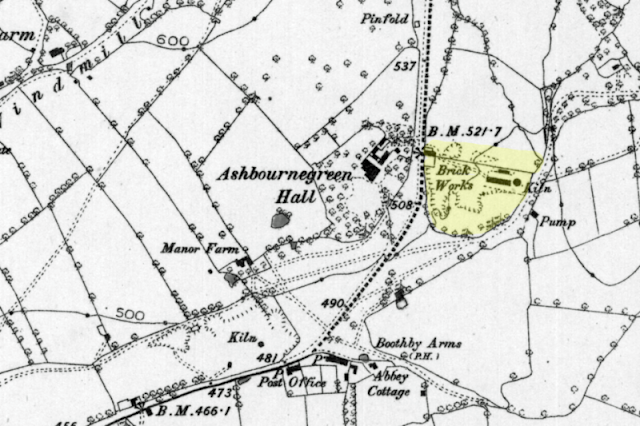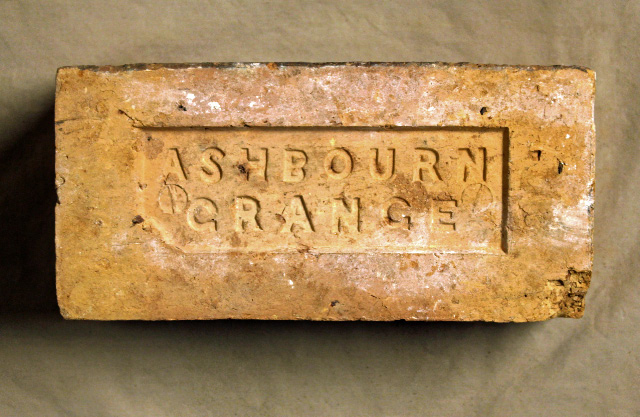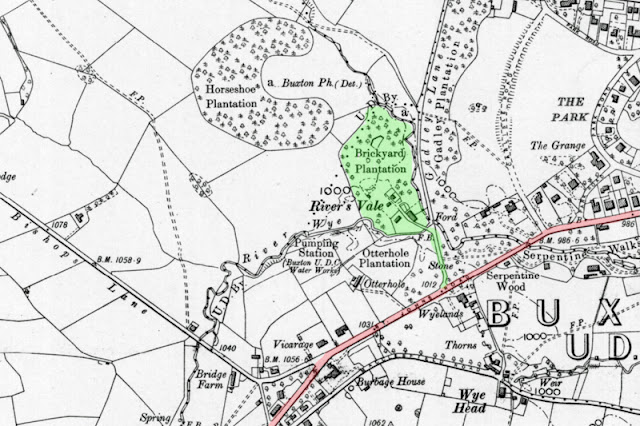Ashbourne
© Crown Copyright. Reproduced by permission of NLS/Ordnance Survey 1879.
Viewing maps of the area has revealed that in the late 1800's there were two brick works in Ashbourne Green, which is about a mile north-east from the centre of Ashbourne. On this first map dated 1879 the works was opposite Ashbourne Green Hall & the track which passes between the two is now the B5035 road to Carsington.
I have found five entries for brickmakers who are listed at Ashbourne Green, Offcote & Underwood, Ashbourne, Derbys. in Kelly's directories, with the first four working at this first site as shown on the 1879 map above. They are W. Tunstall, Kelly's 1855. A January1864 notice in the Staffordshire Recorder reports William Tunstall had passed away & the Trustees of his Will was selling the brickworks as a going concern. The notice goes on to say William had successfully worked the yard for the last 30 years & had produced high class bricks which had been well favoured by builders in Ashbourne. R. Archer is listed in Kelly's 1864 edition, so was the purchaser of the works. Kelly's 1887 edition records W.N. Archer, possibly R. Archer's son. A notice in the Derbyshire Advertiser dated 23rd November 1888 records William N. Archer was selling the brickworks by Tender. Then it's W. Mason in Kelly’s 1895 edition, so it appears W. Mason won the Tender in 1888. The fifth listing is for the Ashbourne Brick, Tile & Pipe Co. Ltd in Kelly’s 1899 to 1904 editions with William Hart as secretary & these dates then match up to the second site which was not very far from the first & can be seen on the second map dated 1898 below. It appears between 1904 & 1908 the company got into financial difficulties with the London Gazette dated 21st November 1908 reporting the Ashbourne Brick, Tile & Pipe Co. Ltd. had been struck off the Joint Stock Register. This normally happens when a company goes bankrupt & is not wound up by a liquidator. So why the company was not wound up by the owner is a bit of a mystery. My next find was in the Derbyshire Advertiser dated 16th of July 1909 when the brickworks was being Auctioned as a going concern on the 24th of July. Who was selling the works is not recorded, it may have been the owner ??? It then appears the brickworks was not sold on the 24th with a notice in the Ashbourne News Telegraph dated 15th October 1909 advertising the Dismantling Sale of all Fixed & Loose Brickmaking Plant, Machinery & Stock at the Ashbourne Green Brickyard, also the sale of all of the buildings in suitable lots. Again no mention of who had instigated the sale. So in a nutshell that was the end of brickmaking in Ashbourne Green.
© Crown Copyright. Reproduced by permission of NLS/Ordnance Survey 1898.
Photo by Dave Penney.
I photographed the Ashbourne Green & Grange bricks at the Silk Mill Museum Derby in October 2015, but since then Dave Penney has sent me a much better image of the Green brick. More than likely the Green brick was made at the first works & the Grange brick may have been made at the second. With the trade directory entries recording Offcote in the address, I have found that located near to the second works today there is a house called Offcote Grange, so there could be some connection to the naming of this Ashbourne Grange brick, but I have to note that on the 1898 map this large house is shown as The Grove. The Grove/Offcote Grange may have been where the owner of the Ashbourne Brick & Tile Co. lived ? If I get confirmation on this theory I will update the post.
Photo taken at the Silk Mill Museum, Derby.
Buxton
The Buxton Stone, Brick & Tile Co. Lim. is listed in Kelly's 1876 edition at Fairfield, Buxton with William F. Hill recorded as secretary. In the 1881 edition C.F. Wardley is now listed as the secretary at the works. The 1878 map below shows two brick yards on Brown Edge Lane (today this road is called Brown Edge Road) & the yellow coloured yard is marked as brick & tile, so I am taking it that this was the works operated by the Buxton Stone, Brick & Tile Co. There are no more listings in trade directories at this date so who owned the other yard is unknown.
© Crown Copyright. Reproduced by permission of NLS/Ordnance Survey 1878.
I now write about the two glazed fireclay bricks which are stamped Pioneer Co. Buxton, but as you will read these bricks were more than likely made in Lancashire.
Photo by David Kitching.
Photo by Jason Stott.
The Pioneer Blue Brick & Fire Clay Co. Ltd. is listed in Kelly's 1904 edition with F. Cowley Smith as secretary & the central offices address of Terrace Road, Buxton. There is no address for the works & neither the 1898 or 1919 maps show any brickworks marked in or around Buxton, not even on Brown Edge Lane the previous location for two brick yards in Buxton. With the company name saying blue brick & fireclay this normally indicates that the clay is being found deep underground, but there are no fireclay mines shown on these Buxton maps either.
I then found this information from a list of mines operating in Lancashire in 1908. The Pioneer Blue Brick & Fireclay Co. is listed as operating the Thornlee mine (fireclay) at Grotton, Lees near Oldham with Thomas Jones as manager. The entry then records the mine as discontinued. So if there is a connection to Buxton & these bricks were made in Lancashire, why stamp their bricks Buxton ??? The only connection with Buxton is the listing of it's Central Offices.
The 1904 map below confirms that the Pioneer Glazed Brick Works was in Lancashire & the Pioneer Company only had it's head office at Buxton. We may never find out why they did not stamp their bricks Grotton or Oldham. So technically speaking they are not Derbyshire bricks unless I find new information which says that the company did have a brickworks in Buxton. Also to note is why the trade directory entry says Central Offices Buxton, did the company have another works in the West Midlands making it's blue bricks from the etruria marl clay which is found in that area & Buxton was the central location for it's offices between the two works ? I have not been able to find any reference to the Pioneer Co. in the West Midlands, but if I do I will update the post.
© Crown Copyright. Reproduced by permission of NLS/Ordnance Survey 1904.
With Jason Stott photographing a Pioneer Co. Buxton, Works Lees, Oldham brick, I have now added it to the post with this brick confirming Pioneer glazed bricks were indisputably made in Lancashire. Many Thanks, Jason.
When originally studying maps of Buxton for brickworks I spotted a wooded area called Brickyard Plantation just off St. Johns Road (see map below) which I was unable to find any information about, but with now talking to Buxton local historian, Colin Wells I can now reveal the answer.
Colin tells me that the brickyard was owned in the 1860's by Robert Rippon-Duke, a Buxton architect who was in partnership with builder Samuel Turner, designing & building/re-building many properties in Buxton. So it appears that the duo made bricks for their own projects. Robert Rippon-Duke is first associated in the building of the Royal Hotel in 1851, then he designed the dome for the Concert Hall, Pavilion Gardens & then the dome for the Devonshire Royal Hospital. Whether Rippon-Duke stamped his bricks is unknown, so if you come across any please let me know.
With Jason Stott photographing a Pioneer Co. Buxton, Works Lees, Oldham brick, I have now added it to the post with this brick confirming Pioneer glazed bricks were indisputably made in Lancashire. Many Thanks, Jason.
Photos by Jason Stott.
Colin tells me that the brickyard was owned in the 1860's by Robert Rippon-Duke, a Buxton architect who was in partnership with builder Samuel Turner, designing & building/re-building many properties in Buxton. So it appears that the duo made bricks for their own projects. Robert Rippon-Duke is first associated in the building of the Royal Hotel in 1851, then he designed the dome for the Concert Hall, Pavilion Gardens & then the dome for the Devonshire Royal Hospital. Whether Rippon-Duke stamped his bricks is unknown, so if you come across any please let me know.
© Crown Copyright. Reproduced by permission of NLS/Ordnance Survey 1897.
Glossop
© Crown Copyright. Reproduced by permission of NLS/Ordnance Survey 1938.
My first reference to this brickworks comes from Kelly's 1936 & 41 editions when John Greenwood (Brickworks) Co. Ltd. is listed at Railway Street, Glossop & works Monslow, Dinting, Glossop. From other information found I have established that the brickworks was at Mouselow Quarry although not marked as such on the 1938 map above. The 1879 map just shows a quarry with no buildings, then the 1897 map shows one building then the 1919 & 38 maps show two buildings & a tramway to the quarry face. Could these buildings be the brickworks ?
Photo by Frank Lawson.
My second reference to a brickworks at Mouselow Quarry comes from a National Archives document which records an application by the Glossop Brickworks Ltd. to extract shale clay & brick earth from land adjoining Hounslow Quarry (this should read Mouselow) in 1958/9.
I expect this brick was made in the late 1950's/ early 60's by the Glossop Brickworks Co. Ltd.
My next reference to this brickworks is in 1975 when J. & A. Jackson of Denton, Manchester are recorded as adding the Glossop works to their portfolio of owned brickworks. The brickworks may have closed under Jackson's ownership some time before 1994, as my final reference is the 2011 application by Wienerberger to continue extracting clay shale from their Mouselow Quarry until 2042 as originally approved in 1994. I have found that after Jackson's became the Chelwood Brick Co., this new company was later acquired/ taken over by Wienerberger resulting in Wienerberger owning the Mouselow Quarry today.
Many Thanks to
David Kitching
Frank Lawson
Dave Penney
Jason Stott
Jason Stott
Derby Silk Mill Museum
National Library of Scotland/ Ordnance Survey

















No comments:
Post a Comment
You can leave a comment if you have a Gmail address or a Google account. I only receive your name & comment from Google. I do NOT receive your email address when you post a comment, SO if you want to contact me & need a reply please use my email address which is on the Links & Contact Tab. Comments are not shown on the blog until I publish them.
Note: only a member of this blog may post a comment.